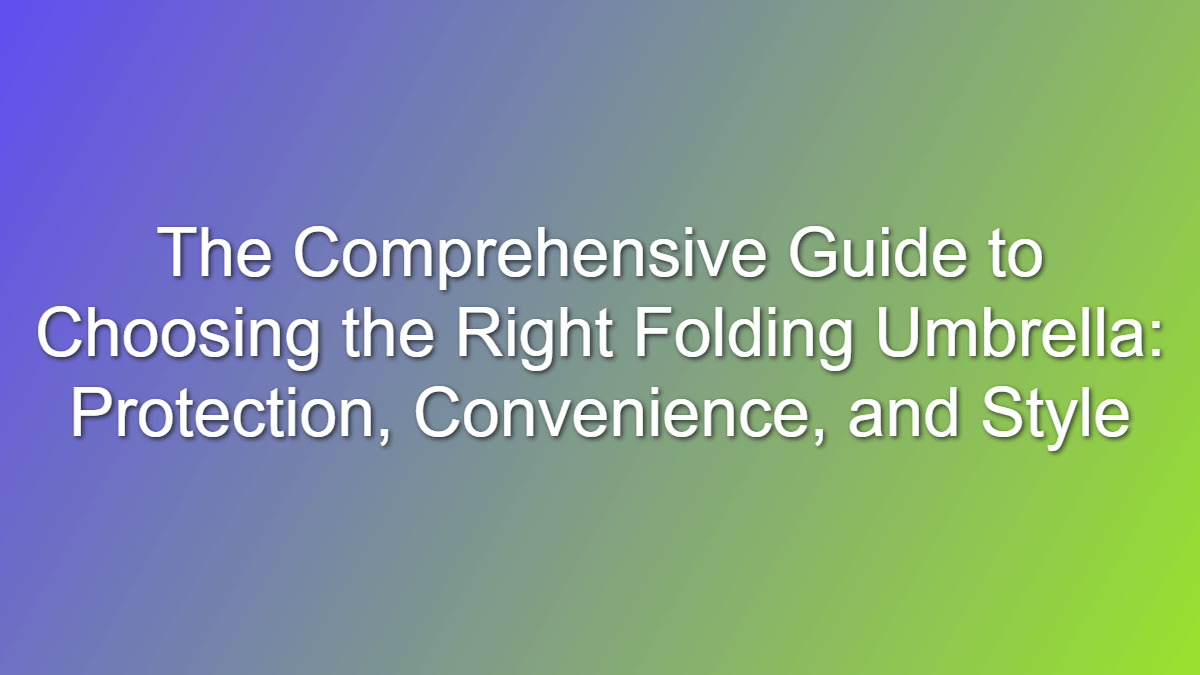Blog
The Science Behind Folding Umbrellas: A Comprehensive Guide for Consumers

1. Introduction
Folding umbrellas are a common accessory, especially in urban environments where unpredictable weather is the norm. They are valued for their portability and ease of use, making them a staple in purses, briefcases, and backpacks. But what makes a folding umbrella different from a regular umbrella? What should you look for when buying one? This article aims to answer these questions by exploring the anatomy, materials, and technology that go into making a high-quality folding umbrella.
2. The Anatomy of a Folding Umbrella
A folding umbrella consists of several key components, each playing a crucial role in its functionality. Here’s a breakdown:
- Canopy: The canopy is the fabric that shields you from rain. It’s typically made from water-resistant materials such as polyester or nylon. High-end umbrellas may use Teflon-coated fabric for extra water repellency.
- Ribs: The ribs are the framework that supports the canopy. They are usually made of steel, aluminum, or fiberglass. Fiberglass is particularly popular because of its flexibility and resistance to breaking in strong winds.
- Shaft: The shaft is the central pole that holds the umbrella. In folding umbrellas, this shaft is collapsible, typically made from lightweight materials like aluminum or composite alloys to balance strength and portability.
- Handle: The handle is where you grip the umbrella. It’s often made from plastic, wood, or rubber, with ergonomic designs to ensure comfort during use.
- Spring Mechanism: The spring mechanism allows the umbrella to open and close. In automatic models, this mechanism is enhanced with a push-button system for ease of operation.
3. Materials: What Makes a Good Folding Umbrella?
The choice of materials in a folding umbrella determines its durability, weight, and overall performance. Here’s what you need to know:
3.1 Canopy Materials
- Polyester: Durable and water-resistant, polyester is a common choice for umbrella canopies. It’s lightweight, dries quickly, and can be coated with various substances to enhance its water repellency.
- Nylon: Known for its strength and flexibility, nylon is another popular choice. It’s more resistant to wear and tear than polyester but can be more expensive.
- Teflon Coating: This is often applied to high-end umbrellas to make the fabric highly water-resistant, causing water to bead up and roll off quickly.
3.2 Frame and Shaft Materials
- Steel: Strong and durable, steel is used in many budget umbrellas. However, it’s heavier than other materials and can rust if not properly cared for.
- Aluminum: Lightweight and rust-resistant, aluminum is a preferred choice for mid-range umbrellas. It offers a good balance between strength and weight.
- Fiberglass: The most premium option, fiberglass is both lightweight and flexible. It’s resistant to rust and breakage, making it ideal for windy conditions.
4. Types of Folding Umbrellas
Folding umbrellas come in various types, each designed to meet specific needs:
4.1 Manual Folding Umbrellas
These require you to manually push or pull the umbrella open and closed. They are often lighter and less expensive but can be less convenient in a sudden downpour.
4.2 Automatic Folding Umbrellas
With a push of a button, these umbrellas automatically open and close. They offer greater convenience but are slightly heavier due to the additional mechanics.
4.3 Windproof Folding Umbrellas
Designed to withstand strong winds, these umbrellas typically feature reinforced frames and flexible ribs. Fiberglass is commonly used in their construction.
4.4 Compact Folding Umbrellas
These are the smallest and lightest, designed to fit easily in a purse or pocket. They trade off some durability and coverage area for portability.
5. How to Choose the Right Folding Umbrella
When choosing a folding umbrella, consider the following factors:
- Purpose: Are you looking for an everyday carry umbrella, or do you need something specifically for travel? Compact umbrellas are best for daily carry, while larger ones may be more suitable for extended outdoor use.
- Material: Depending on your environment, you may prefer a lightweight aluminum frame or a more durable fiberglass one.
- Wind Resistance: If you live in a windy area, opt for an umbrella with windproof features, such as a fiberglass frame and a vented canopy.
- Size and Weight: Consider the trade-off between portability and coverage. A larger canopy provides more protection but will be bulkier.
- Ease of Use: Automatic umbrellas are convenient but may weigh more. Manual ones are lighter but require more effort to operate.
For more detailed guidance, you can refer to the folding umbrellas section on the KUQIX website here.
6. Maintenance and Care
Proper care can significantly extend the life of your folding umbrella. Here are some tips:
- Dry Before Storing: Always let your umbrella fully dry before storing it. Storing it wet can lead to mildew and rust on the metal parts.
- Clean Regularly: Use a damp cloth to clean the canopy and frame. Avoid harsh chemicals that could damage the fabric or coating.
- Check for Damage: Regularly inspect your umbrella for any signs of wear, especially on the ribs and canopy. Repair any small tears or bent ribs before they worsen.
- Storage: Store your umbrella in a cool, dry place. Avoid leaving it in direct sunlight for extended periods, as this can weaken the fabric and fade the colors.
7. Environmental Considerations
Sustainability is becoming increasingly important to consumers. When purchasing a folding umbrella, consider the environmental impact:
- Material Sourcing: Look for umbrellas made from recycled or sustainable materials. Some companies are now offering umbrellas made with eco-friendly fabrics and frames.
- Durability: A well-made umbrella that lasts several years is more environmentally friendly than a cheap one that needs frequent replacing.
- Disposal: When your umbrella reaches the end of its life, dispose of it responsibly. Some parts, like the aluminum shaft, can be recycled.
For those interested in the eco-conscious aspects of folding umbrellas, the KUQIX website offers various options and more information on their commitment to sustainability here.
8. Conclusion
Folding umbrellas are a vital tool for staying dry and comfortable in wet weather. By understanding the materials, mechanics, and designs of these umbrellas, consumers can make informed decisions that lead to better performance and longevity. Whether you need a compact, everyday umbrella or a sturdy windproof model, there’s a folding umbrella to suit every need. Remember to consider the factors discussed in this article when making your next purchase, and always invest in quality to ensure you stay protected, rain or shine.
For further information on folding umbrellas, bulk orders, or customer service, visit the KUQIX website’s various sections, such as their business services, contact page, or shipping and returns policies.


